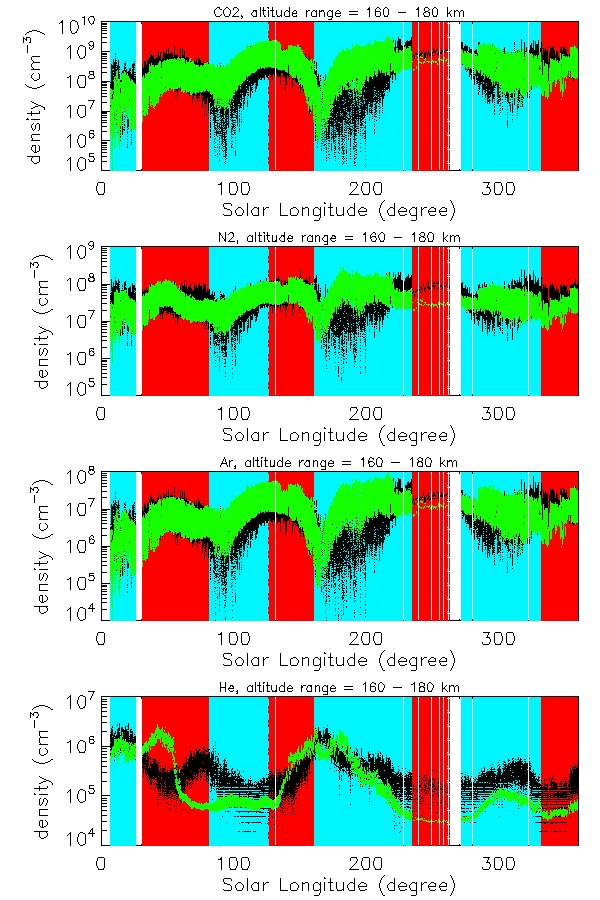3D model of the Martian thermosphere with PCM-Mars : Comparison between the simulated CO2, N2, Ar and the MAVEN/NGIMS measurements
- 1CNRS, LATMOS, Paris, France (chaufray@latmos.ipsl.fr)
- 2IAA, CSIS, Granada, Spain
- 3LMD-IPSL, CNRS, Paris, France
Abstract
In this study, we simulate the density of four important species in the Martian upper atmosphere (CO2, N2, Ar and He) with Mars-PCM. We use a new numerical approach to compute the molecular diffusion, including an eddy diffusion term to better describe the transition between the homosphere and the heterosphere. We compare the simulated densities of these species with the numerous observations done by the mass spectrometer NGIMS on MAVEN during several martian years.
Introduction
The thermosphere is the upper region of the atmosphere, below the exobase, above which collisions between species are not important. This region absorbs the EUV solar radiation leading to an important and complex set of chemical reactions crucial to understand fundamental processes such as atmospheric escape. The MAVEN mission has provided an unprecedented set of observations of the Martian thermosphere during more than 10 years of observations. These observations include measurements of the composition of the Martian thermosphere done by the mass spectrometer NGIMS [1] which measures the density of ions and neutrals. These observations are crucial to validate models of the Martian thermosphere such as PCM-Mars [2]. To start a systematic comparison between the simulated thermosphere and MAVEN observations, we focus on the main species CO2, and the major chemically inert or almost inert species (N2, Ar, He).
Model
PCM-Mars is a 3D model of the Martian atmosphere from the surface to the exobase [2, 3]. This model includes all important physical processes controlling the Martian thermosphere, including: heating and cooling processes, dynamics, chemistry and molecular diffusion [3, 4, 5] and can be used to simulate generic scenarios for theoretical studies or specific scenarios corresponding to specific Martian years. We recently update the numerical scheme used to solve the vertical diffusion equation including eddy mixing. Instead of a matrix inversion [5], the new method used the faster “modified pass flow” algorithm [6, 7] based on the calculation of a recurrence sets, expanded to solve the time dependent equation of diffusion. We also added an eddy diffusion to better describe the thermosphere. The eddy mixing ratio used for this comparison is taken from [8] and expressed by
K(z) = K0[Texo/n(z)]1/2
where K0 is a free parameter, chosen to 1.2x1011 cm2.s-1 [8] for the comparison below.
Results and discussion
A first set of comparison between a generic scenario and the observations by MAVEN/NGIMS during the Martian year 33 is shown below.

Fig. 1 Comparison between the observed density (black dots) and the simulated density (green dots) of CO2 (first panel), N2 (second panel), Ar (third panel) and He (last panel) during the Martian year 33. The blue background corresponds to nightside observations and the red background to dayside observations, while white backgrounds are periods without observations.
The observed density and the simulated densities for the four species are in general agreement but some differences can be noted. The large variations observed by NGIMS for CO2, N2 and Ar are mostly due to local time variations (with lower densities at the nightside than dayside). This trend is present but slightly underestimated by the model near Ls = 80° and between Ls = 160- 200° (corresponding to a local time varying from 6 am to midnight). During this last period, the density of the three species is overestimated except near 6 am, possibly due to an overestimate of the temperature. For He (last panel), the night (morning) bulge detected by NGIMS near Ls = 180° is reproduced by the model but the bulge observed near Ls = 80° (morning) is not simulated (possibly due to a lower latitudinal extent of the simulated bulge), while the nigthside bulge observed near Ls = 300° is underestimate by a factor ~ 2.
Conclusion
This first comparison between the simulated density of CO2, N2, Ar, and He with MAVEN/NGIMS measurements shows that the order of magnitude of the simulated densities between 160 and 180 km agree with the observations at the dayside, while at the nightside important differences can be noted. The observed spatio-temporal variations of He differs from CO2, Ar and N2. PCM-Mars also predicts different variations due to the low mass of He, but the predicted variations for He differ substantially from the observed variations, while for CO2, Ar, N2 the main trends are better reproduced. Simulations (dust scenario, solar radiation) specific to the different Martian years will be performed to better understand if some of the differences can be explained. One important difference could be due to an overestimate of the nightside temperature in PCM-Mars.
Aknowledgements
JYC is supported by the Programme National de Planétologie (PNP, France) of CNRS-INSU co-funded by CNES and Programme National Soleil Terre (PNST, France) of CNRS-INSU co-funded by CNES and CEA
References
[1] Bougher, S. et al., Science, 350, (2015)
[2] Forget et al., J. Geophys. Res., 104, 24155-24175, (1999)
[3] Gonzalez-Galindo, F. et al., J. Geophys. Res., 114, E04001, (2009)
[4] Gonzalze-Galindo, F. et al., J. Geophys. Res., 120, 2020-2035, (2015)
[5] Chaufray, J-Y et al., Icarus, 245, 282-294, (2015)
[6] Parshev, V.A., Preprint N 387, Space Sci. Inst., USSR Academy of Science, (1978)
[7] Krasnopolsky, V., Icarus, 101, 313-332, (1993)
[8] Krasnopolsky, V., J. Geophys. Res., 107, E12, 5128, (2002)
How to cite: Chaufray, J.-Y., Gonzalez-Galindo, F., Forget, F., Gilli, G., Millour, E., Leblanc, F., Modolo, R., and Lopez-Valverde, M.: 3D model of the Martian thermosphere with PCM-Mars : Comparison between the simulated CO2, N2, Ar and the MAVEN/NGIMS measurements, Europlanet Science Congress 2024, Berlin, Germany, 8–13 Sep 2024, EPSC2024-317, https://doi.org/10.5194/epsc2024-317, 2024.